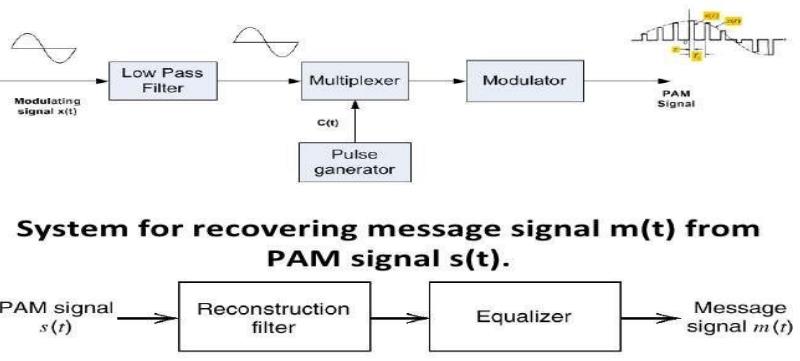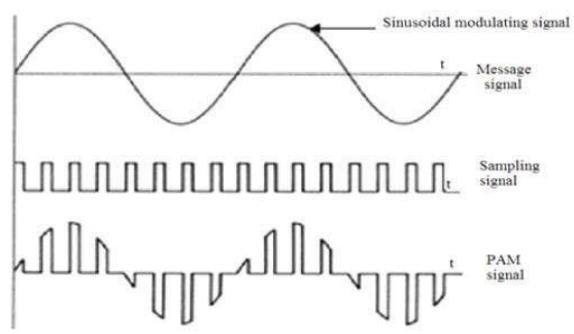Pulse Amplitude Modulation (PAM)
It is useful and important to generate a continuous-time (CT) signal from a sequence in communication systems, in which discrete data—for example, digital or quantized data — is to be transmitted over a channel in the form of a continuous-time signal. Unlike in the case of discrete-time (DT) processing of CT signals, the resulting continuous-time signal will be converted back to a discrete-time signal at the receiving end.

Pulse–amplitude modulation (PAM) is a form of signal modulation
where the message information is encoded in the amplitude of a
series of signal pulses.
The basic idea in PAM for communication over a CT channel is to
transmit a sequence of CT pulses of some pre-specified shape p(t),
with the sequence of pulse amplitudes carrying the information.

Fig: Block Diagram of PAM Generation

Fig: Pulse Amplitude Modulation Signal
The message signal and the sequence of amplitude-modulated rectangular pulses whose amplitude is in accordance with the amplitude of the message signal is termed as pulse amplitude modulation signal.
There are two operations involved in the generation of the PAM
signal
1. Instantaneous sampling of the message signal (say, m(t)) every Ts
seconds, where the sampling rate, fs = 1/ Ts is chosen in accordance
with the sampling theorem.
2. Lengthening the duration of each sample so obtained to some
constant value T.
Let s(t) denote the sequence of flat-top pulse amplitude signal
generated then we may express the PAM signal as
s(t) = ∫_(n= -∞)^∞▒〖m(nT_s 〗). h(t - nT_s)
where Ts is the
sampling period m(nTs) is the sample value of m(t) obtained at time
t = nT_s .
Demodulation
Demodulation is performed by detecting the amplitude level of the carrier at every single period. The number of possible pulse amplitudes in analog PAM is theoretically infinite. Digital PAM reduces the number of pulse amplitudes to some power of two. For example, in 4-level PAM there are 22 possible discrete pulse amplitudes; in 8-level PAM there are 23 possible discrete pulse amplitudes; and in 16-level PAM there are 24 possible discrete pulse amplitudes.
Applications
The translation of a DT signal to a CT signal appropriate for
transmission, and the translation back to a DT signal at the
receiver, are both accomplished by devices referred to as modems
(modulators/demodulators). Pulse Amplitude Modulation (PAM)
underlies the operation of a wide variety of modems.
Power consumption is low in pulse modulation. Explanation: In pulse
modulation, the carrier is not transmitted continuously but in
pulses whose width is determined by the amplitude of the modulating
signal.
Effect of Noise on Pulse Amplitude Modulation
The frequency varies according to the modulating signal or message signal. Due to these variations in the signal frequency, interferences will be there. So the noise will be great. For PAM, noise immunity is less when compared to other modulation techniques. It is almost equal to amplitude modulation.
